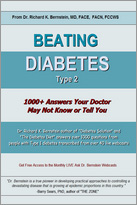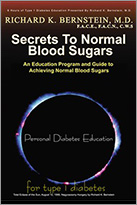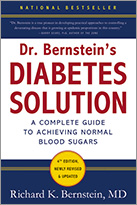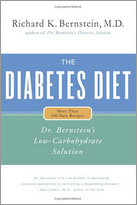WHAT ABOUT DIETARY FIBER?
“Fiber” is a general term that has come to refer to the undigestible portion of many vegetables and fruits. Some vegetable fibers, such as guar and pectin, are soluble in water. Another type of fiber, which some of us call roughage, is not water soluble. Both types appear to affect the movement of food through the gut (soluble fiber slows processing in the upper digestive tract, while insoluble fiber speeds digestion farther down). Certain insoluble fiber products, such as psyllium, have long been used as laxatives. Consumption of large amounts of dietary fiber
is usually unpleasant, because both types can cause abdominal discomfort, diarrhea, and flatulence. Sources of insoluble fiber include most salad vegetables. Soluble fiber is found in many beans, such as garbanzos, and in certain fruits, such as apples.
I first learned of attempts at using fiber as an adjunct to the treatment of diabetes about twenty-five years ago. At that time, Dr. David Jenkins, in England, reported that guar gum, when added to bread, could reduce the maximum postprandial blood sugar rise from an entire meal by 36 percent in diabetic subjects. This was interesting for several reasons. First of all, the discovery occurred at a time when few new approaches to controlling blood sugar were appearing in the medical literature. Second, I missed the high-carbohydrate foods I had given up, and hoped I might possibly reinstate some. I managed to track down a supplier of powdered guar gum, and placed a considerable amount into a folded slice of bread. I knew how much a slice of bread would affect my blood sugar, and so as an experiment, I used the same amount of guar gum that Dr. Jenkins had used, and then ate the concoction on an empty stomach. The chore was difficult, because once moistened by my saliva, the guar gum stuck to my palate and was difficult to swallow. I did not find any change in the subsequent blood sugar increase. Despite the unpleasantness of choking down powdered guar gum (which is often used in commercial products such as ice cream as a thickener), I repeated this experiment on two more occasions, with the same result. Subsequently, some investigators have announced results similar to those of Dr. Jenkins, yet other researchers have found no effect on postprandial blood sugar. In any event, a reduction of postprandial blood sugar increase by only 36 percent really isn’t adequate for our purpose, since we’re shooting for the same blood sugars as nondiabetics. This means virtually no rise after eating.
*To complicate things somewhat, a 1998 report in the Journal of Clinical Endocrinology and Metabolism demonstrated that salt restriction in nonhypertensive type 2 diabetics reduced insulin sensitivity by 15 percent. A prior article in the American Journal of Hypertension found a similar effect in hypertensive individuals. Another study of rats, published in the journal Diabetes in 2001, found that this insulin resistance cannot be reversed by the insulin-sensitizing agent pioglitazone.
Dr. Jenkins also discovered, however, that the chronic use of guar gum resulted in a reduction of serum cholesterol levels. This is probably related to the considerable recirculation of cholesterol through the gut. The liver secretes some cholesterol into bile, which is released into the upper intestine. This cholesterol is later absorbed lower in the intestines, and eventually reappears in the blood. Guar binds the cholesterol in the intestines, so that rather than being absorbed, it appears in the stool. In the light of these very interesting results, other researchers studied the effect of foods (usually beans) containing other soluble forms of fiber. When beans were substituted for faster-acting forms of carbohydrate, postprandial blood sugars in diabetics increased more slowly, and the peaks were even slightly reduced. Serum cholesterol levels were also reduced by about 15 percent. But subsequent studies, reported in 1990, have uncovered flaws in the original reports, casting serious doubt upon any direct effect of these foods upon serum lipids. In any event, postprandial blood sugars were never normalized by such diets. Many popular articles and books have appeared advocating “high- fiber” diets for everyone—not just diabetics. Somehow, “fiber” came to mean all fiber, not just soluble fiber, even though the only viable studies had utilized such products as guar gum and beans.
In my experience, reduction of dietary carbohydrate is far more effective in preventing blood sugar increases after meals. The lower blood sugars, in turn, bring about improved lipid profiles.
A recent food to join the high-fiber trend is oat bran. This has gotten a lot of play in the popular press. A patient of mine started substituting oat bran muffins for protein in her diet. Before she started, her HgbA1C (see Chapter 2) was within the normal range and her ratio of total cholesterol to HDL was very low (meaning her cardiac risk ratio was low). After three months on oat bran, her HgbA1C became elevated and her cholesterol-to-HDL ratio nearly doubled. I tried one of her tiny oat bran muffins after first injecting 3 units of fast-acting insulin (as much as I use for an entire meal). After 3 hours, my blood sugar went up by about l00 mg/dl, to 190 mg/dl. This illustrates the adverse effect that most oat bran preparations can have upon blood sugar. This is because most such preparations contain flour. On the other hand, I find that certain bran products, such as the bran crackers listed in Chapter 10, raise blood sugar very little. Unlike most packaged bran products, they contain mostly bran and little flour. They therefore have very little digestible carbohydrate. You can perform similar experiments yourself. Just use your blood glucose meter. Beware of commercial “high-fiber” products that promise cholesterol reduction. If they contain carbohydrate, they must at least be counted in your meal plan and will probably render little or no improvement in your lipid profile.
Fiber, like carbohydrate, is not essential for a healthy life. Just look at the Eskimos and other hunting populations that survive almost exclusively on protein and fat, and don’t develop cardiac or circulatory diseases.*
WHAT ABOUT THE GLYCEMIC INDEX?
For a number of years, the term “glycemic index” has popped in and out of the popular press. It also has been a pet subject for many dietitians and diabetes educators. I will explain why, but I think it’s important to make clear that there is simply no way to determine objectively how any given food at any given time is going to behave in any given individual, unless blood sugar is tested before and for a number of hours after its consumption. It sounds like an elegant idea—mashed potatoes do X; table sugar does Y. As with a lot of elegant ideas, however, the reality is far more complex.
*As the first edition of this book was going to press, a report appeared entitled “Dietary Fiber, Glycemic Load, and Risk of Non-Insulin-Dependent Diabetes in Women” (Jnl Amer Med Assoc 1997; 277:472–477). This study of 65,173 nurses and former nurses found a strong association between diets high in starch, flour, and sweet foods and the development of type 2 diabetes. Furthermore, consumption of minimally refined grain (such as bran without flour) lowered this risk. The combination of high glycemic foods and low intake of unrefined insoluble fiber was associated with a 2.5-fold higher incidence of diabetes. If you remember our discussion of beta cell burnout (pages 39–42), this should come as no surprise.
This term was, as I recall, first coined by the same Dr. Jenkins mentioned in the above section. The concept is more complicated than the popular press would have you believe.
Imagine two graphs, each depicting a curve of a blood sugar increase over a 3-hour time span. The first curve is after eating pure glucose, the standard. The second is after eating any other food of equivalent total carbohydrate content (20 grams glucose versus 20 grams carbohydrate
content of, say, rice).
Dr. Jenkins defined the glycemic index for a given food in terms of how its curve related to that of the glucose curve.
So to arrive at the index for rice, for example, the area under the 3- hour curve of blood sugar increase caused by the rice would be divided by the area under the curve for pure glucose. The measurement is usually made on a number of nondiabetics and then averaged, and finally expressed as a percent. Thus, if a food generates a 3-hour area one-fifth that of glucose, its glycemic index would be 20 percent.
So what’s wrong with that?
As attractive as it may seem, the concept is clearly flawed in three respects: First, diabetics show much higher blood sugar increases than nondiabetics. Second, digestion of the carbohydrate portion of a meal typically takes at least 5 hours (in the absence of gastroparesis), and the index ignores effects upon blood sugar that last longer than 3 hours. Finally, the index is an average, and true numbers have been found to vary considerably from one person to another, from one time to another, and from one study to another. As I’ve pointed out, a food that makes my blood sugar rise dramatically may have little or no effect on that of one of my patients who still makes some insulin.
Unfortunately, many dieticians and diabetes educators still recommend foods that have been “shown” to have a “low” glycemic index in some study, and assume that an index of 40 or 50 percent is low. They may thus select apples, lima beans, and the like as appropriate for diabetics, even though consumption of typical portions of these foods will cause considerable blood sugar elevations in diabetics.
A “medium-sized” apple, according to one table of food values, contains 21 grams of carbohydrate. It will raise my own blood sugar by 105 mg/dl, and much more rapidly than I can prevent with an injection of rapid-acting insulin. Peanuts usually have the lowest glycemic index in many studies (about 15 percent), yet 1 ounce contains 6 grams of carbohydrate and close to 1 ounce of protein. I’ve found this portion to raise my blood sugar by 80 mg/dl, albeit much more slowly than the apple. Since peanuts work so slowly (more slowly than 3 hours), I can substitute 1 ounce for 6 grams carbohydrate and 1 ounce protein in a meal—but who can eat only one handful of peanuts?* The carbohydrate foods that we recommend, salads and selected vegetables (Chapter 9), have glycemic indices lower than peanuts and work more slowly. Furthermore, they are more filling. The issue here, though, is to understand that such indices are unreliable and won’t help you keep your blood sugars normalized.
WHAT DIET WILL WORK FOR YOU?
Actual results are the yardstick for an appropriate diet. We have the tools for self-monitoring of blood sugar and blood pressure. We have tests for measuring kidney function, HgbA1C, thrombotic risk profiles, and lipid profiles (see Chapter 2). Under your doctor’s supervision, try our diet recommendations for at least three months. Then try any other diet plan for three months and see what happens. The differences may not be in the direction that the popular literature would predict.
Finally, in its most common usage, “diet” usually indicates some sort of franchise. “The______Diet” (you can fill in the blank) usually has a particular name or marketing term associated with it and often comes with products ready for your consumption. When I use the term, I’m referring to diet in the very simple sense of what you eat. I’m not selling a brand or products, but providing guidelines so that you can understand how foods are likely to affect you. You can then create your own diet, one that will not only allow you to keep your blood sugars normalized but also to satisfy yourself.
*By the way, natural peanut butter has a glycemic index much higher than that of the peanuts from which it was created because it is digested more rapidly.




